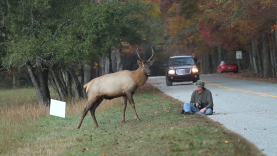

An incredible Nature Lens YouTube channel video shows an unusual creature that looks strikingly similar to a snake, except it’s not a snake—it’s fooling us all, including its predators.
The creature appears to have big black eyes on the sides of a wide, rounded head. There’s even a point beneath its eyes that looks exactly like the mouth of a snake.
A brownish stripe runs down this imposter’s body with a scale-like pattern, and it has a lighter-colored belly—all common features of real snakes.

Many creatures use camouflage to survive, including a type of camouflage called mimicry. Animal species camouflage themselves by changing color and even changing the shape of their body. The ability to change the color, pattern, and opacity of their skin in order to blend in with their environment helps these species avoid predators.
Camouflage can make it hard to figure out what the animal actually is, and that’s the point. In this case, the snake-like animal is actually a hawk moth caterpillar.
“Before becoming a moth, the hawk moth caterpillar is defenseless so it has to develop this incredible ability to fool predators into thinking that it’s a dangerous threat,” the video summarizes.
The hawk moth caterpillar is “uncannily similar to a snake” and even takes it to a new level by acting like a snake. When threatened, it rears its “head” like a snake would.
“I would 100% think it’s a snake if I saw it in the wild,” one commenter writes.
Would this caterpillar fool you if you saw it in the wild? Tell us in the comments below.










Very interesting!
Please be careful with the language. The sentence “Before becoming a moth, the hawk moth caterpillar is defenseless so it has to develop this incredible ability to fool predators into thinking that it’s a dangerous threat,” the video summarizes can lead to misconceptions. The moth does not develop an ability. The mimicry was, and continues, to be selected, for and against, by natural selection. The article gives the impression the moth makes a choice. It doesn’t.